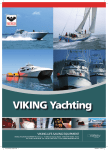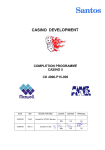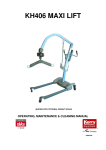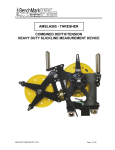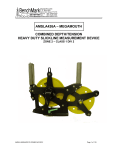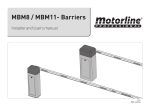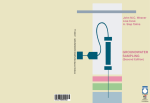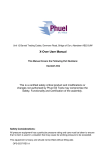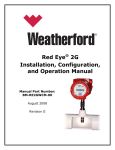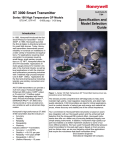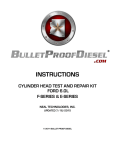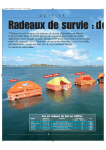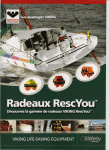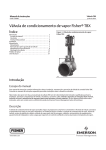Download Completion Barrier Valve (patent applied for)
Transcript
Issue B Date 29-03-10 Technical Manual Completion Barrier Valve Number: 0000030000 (patent applied for) Description The Caledyne Completion Barrier Valve (CBV) is a down-hole barrier valve, which uses a ball to provide isolation between the upper and lower completions. The CBV may be opened remotely by applying tubing pressure cycles, which actuate an opening mechanism at the top of the tool. The CBV may be mechanically opened and closed with a shifting tool, both before and after it is cycled open. Key Benefits Forces due to pressure differentials across the ball do not affect the open/close mechanism or the remote opening module. Smooth internal bore with a minimal number of locations for debris to collect. Remote opening module can be replaced for different actuation modules or to vary the number of pressure cycles to open. Multiple remote opening modules may be fitted without increasing the tool length, giving full redundancy across this part of the tool. Internal equalizing mechanism across the ball allows for reduced loads to open the ball under high differential pressures. Trigger mechanism can be independently tested prior to assembling inside the valve. Application • Formation isolation when installing the upper completion. • Packer setting valve Certification Consult your Caledyne representative. © 2010 Page 1 of 9 www.caledyne.co.uk Issue B Date 29-03-10 © 2010 Technical Manual Page 2 of 9 Number: 0000030000 www.caledyne.co.uk Issue B Date 29-03-10 Number: Technical Manual 0000030000 Technical Specification Parameter A B C (min) D (max) E F G H I J Upper connection (note 1) Lower connection (note 2) Shifting Profile Size (note 3) Pressure cycles to open (note 4) Pressure rating across ball Pressure rating through housing Maximum opening pressure Maximum threshold pressure Minimum threshold pressure Maximum overbalance Temperature rating Tensile rating (80ksi Material) 3-1/2” x 7” 4-1/2” x 7” 2674mm (105.3”) 88.90mm (3.500”) 71.73mm (2.824”) 140.08mm (5.515”) 88.90mm (3.500”) 2013.3mm (79.3”) 1135.6mm (44.7”) 967.7mm (38.1”) 628.5mm (24.7”) 895.7mm (35.3”) 3-1/2” 9.2# NEW VAM Pin 3-1/2” 9.2# NEW VAM Pin 2.812” 2744.4mm (108.0”) 114.30mm (4.500”) 82.47mm (3.247”) 149.23mm (5.875”) 114.30mm (4.500”) 2050.2mm (80.7”) 1165.6mm (45.9”) 1002.7mm (39.5”) 643.5mm (25.3”) 925.7mm (36.4”) 4-1/2” 15.1# NEW VAM Pin 4-1/2” 15.1# NEW VAM Pin 3.312” 10,000psi 172,500lbf NEW VAM Yield (1.2 F of S) Metallurgy Options Standard Elastomer Standard Ball Seat WP Shifting Tool Size Stinger Size HEST Base Assembly Size © 2010 2.875” 2.875” 2.200” 4-1/2” x 7-5/8” 5-1/2” x 9-5/8” 2744.4mm 3177.3mm (108.0”) (125.1”) 114.30mm 140.60mm (4.500”) (5.535”) 82.47mm 115.85mm (3.247”) (4.561”) 153.08mm 204.28mm (6.027”) (8.043”) 114.30mm 140.60mm (4.500”) (5.535”) 2050.2mm 2334.6mm (80.7”) (91.9”) 1165.6mm 1455.8mm (45.9”) (57.3”) 1002.7mm 1211.8mm (39.5”) (47.7”) 643.5mm 738.5mm (25.3”) (29.1”) 925.7mm 1095.8mm (36.4”) (43.1”) 4-1/2” 5-1/2” 23# 15.1# NEW NEW VAM VAM Pin Pin 4-1/2” 5-1/2” 23# 15.1# NEW NEW VAM VAM Pin Pin 3.312” 4.562” 1-20 cycles 5,000psi 5,000psi 10,000psi 10,000psi 4,000psi 3,000psi 1,000psi 500psi 0-150°C 294,000lbf 294,000lbf 398,000lbf NEW VAM NEW VAM NEW VAM Yield Yield Yield (1.2 F of S) (1.2 F of S) (1.2 F of S) AISI 4140-45 18-22Rc 80ksi AISI 420 18-22Rc 80ksi 13%Cr Inconel 718 (UNS N07718) per NACE MR0175 Viton PEEK compound 3.312” 3.312” 4.562” 3.312” 3.312” 4.562” 2.200” 2.200” 3.000” Page 3 of 9 5-1/2” x 9-5/8” (Large Bore) 3330.0mm (131.1”) 140.60mm (5.535”) 120.57mm (4.747”) 212.8mm (8.378”) 140.60mm (5.535”) 2428.0mm (95.6”) 1514.0mm (59.6”) 1260.0mm (49.6”) 768.0mm (30.2”) 1140mm (44.9”) 5-1/2” 23# NEW VAM Pin 5-1/2” 23# NEW VAM Pin 4.750” 10,000psi 398,000lbf NEW VAM Yield (1.2 F of S) 4.750” 4.750” 3.000” www.caledyne.co.uk Issue B Date 29-03-10 Bill of Material Description Top Sub Hydrostatic Housing Outer Extension Lower Coupling Ball Housing Lock Housing Bottom Sub Upper Hydrostatic Piston Lower Hydrostatic Piston Profile Sleeve Key Housing Locking Key Snap Ring Hyd Piston Interlock Key Side Plate A Side Plate B Ball Trunnion Ball Seat Assembly Transfer Sleeve Snap Ring Ball Seat Cyclic Trigger Sub No-Go Ring Burst Disc Assembly Adjuster Rod ¼” x ¼” Long Socket Head Set Screw ¼” UNC x ¼” Long Brass Shear Screw Wave Spring O-Ring Viton 70 Back Up Nitrile 90 O-Ring Viton 70 Back Up Nitrile 90 Tee Seal Tee Seal Tee Seal ¼” NPT Flush Plug PLAA2528010A Item 1 2 3 4 5 6 7 8 9 10 11 12 13 14 15 16 17 18 19 20 21 22 23 24 25 26 27 28 29 30 31 32 33 34 35 36 37 38 © Technical Manual 2010 Page 4 of 9 Number: 0000030000 Qty 1 1 1 1 1 1 1 1 1 1 1 8 1 4 1 1 1 2 1 1 1 1 2 1 2 1 5 2 4 5 10 2 4 3 6 2 2 2 www.caledyne.co.uk Issue B Date 29-03-10 Technical Manual Number: 0000030000 Completion Barrier Valve – Locked Closed Position Completion Barrier Valve – Cycled Open Position Completion Barrier Valve – Recommissioned Locked Open © 2010 Page 5 of 9 www.caledyne.co.uk Issue B Date 29-03-10 Technical Manual Number: 0000030000 WP Shifting Tool Stinger HEST © 2010 Page 6 of 9 www.caledyne.co.uk Issue B Date 29-03-10 Number: Technical Manual 0000030000 Shipping/Storage Preparations 1. Ensure the valve is left open. 2. Fit thread protectors to the upper and lower connections. 3. Place the CBV in a suitable shipping crate. Ensure that Silica Gel is included in the crate. Care and Maintenance 1. 2. 3. Ensure thread protectors are fitted to the upper and lower connections at all times. If the tool is being stored for more than 3 months, it should be stored vertically to help prevent the internal o-rings taking a set. The CBV is not field redressable. The tool should be returned to Caledyne or an approved refurbishment facility for redress. Operational Procedures For installation of this item of equipment, refer to the appropriate operations manual, but these notes are given as guidance. The CBV is made up to the tubing string and run in hole. It may be installed either open or closed. Gravel Packing 1. 2. If carrying out gravel packing operations with the CBV, the shifting tool is normally positioned at the end of the wash string, so the CBV is automatically closed when the wash pipe is withdrawn. Once the valve is closed it may be pressure cycled open. Pressure Cycle to Open 1. 2. 3. Apply pressure to the tubing above the maximum threshold pressure as defined in the technical specification. Hold this pressure for 5 minutes. Bleed of pressure to a figure below the minimum threshold pressure as defined in the technical specification. Hold this pressure for 5 minutes. On the bleed down of the last cycle, the valve will open. WP Shifting Tool The WP Shifting tool can be used to shift the CBV open/closed on wash pipe, coil tubing, drill pipe or slickline. 1. Once the valve has been cycled open, the WP shifting tool is used to close it again. The WP shifting tool is set up with shear out keys, so that the internal sleeves are repositioned. 2. Further open and close operations are done with the WP shifting tool set up with auto-release keys. 3. RIH to depth. 4. POOH and latch shifting profile. 5. Jar up to shift profile sleeve and close ball. 6. At full travel the shifting tool will auto-release. 7. POOH. © 2010 Page 7 of 9 www.caledyne.co.uk Issue B Date 29-03-10 Number: Technical Manual 0000030000 Stinger The Stinger is mounted on the bottom of an upper completion. The CBV is installed closed. When the upper completion is installed the WP Shifting Tool will open the valve. On removal, the valve is automatically closed. 1. 2. 3. 4. 5. 6. Fit Stinger to bottom of upper completion. RIH to depth. The Stinger will pick up the lower shifting profile, opening the ball. Continue RIH to depth. To close the ball, POOH with upper completion. The Stinger will pick up the upper shifting profile, closing the ball. Continue POOH. HEST The High Expansion Shifting Tool (HEST) is a coil tubing deployed shifting tool allowing the operator to run through restrictions above the CBV and expand the shifting keys out to locate the profile once at depth. Nozzles at the bottom of the HEST also allow the operator to jet through the tool to clean up profiles prior to shifting. 1. 2. 3. 4. 5. 6. 7. Fit key set to suit CBV profile size into the HEST Base Assembly. Make up the HEST to coiled tubing. RIH to depth. At depth begin jetting through HEST. Increase pressure to value detailed in the HEST Technical Manual to inflate the keys. Pick up the profile and shift the CBV ball open/closed. POOH. Contingency Measures Pressure cycling does not open the valve. 1. 2. 3. 4. 5. 6. 7. Use the WP Shifting Tool or HEST. RIH and tag the ball. POOH and latch shifting profile. Jar down to shift profile sleeve and open ball. At full travel the shifting tool will auto-release. POOH. Further open/close operations can then be carried out using a suitable CBV shifting tool. Debris stops the valve from being mechanically opened. 1. 2. 3. 4. 5. 6. 7. 8. 9. RIH with hydrostatic bailer or similar and remove debris from on top of the ball. POOH. Use the WP Shifting Tool or HEST. RIH and tag the ball. POOH and latch shifting profile. If the profile cannot be latched repeat steps 1 to 6. Once shifting profile is latched, Jar down to shift profile sleeve and open ball. At full travel the shifting tool will auto-release. POOH. Paraffin build up in the Shifting Profiles (or similar) © 2010 Page 8 of 9 www.caledyne.co.uk Issue B Date 29-03-10 1. 2. 3. 4. 5. 6. 7. 8. 9. 10. Number: Technical Manual 0000030000 Fit key set to suit CBV profile size into the HEST Base Assembly. Make up the HEST to coiled tubing. RIH to depth. At depth begin jetting through HEST with suitable solvent. Travel in/out of hole jetting all profiles. Increase pressure to value detailed in the HEST Technical Manual to inflate the keys. Pick up the profile and attempt to shift the CBV ball open/closed. If the sleeve is still unable to move repeat steps 4 to 6 until the sleeve can move freely. Continue to shift ball open/closed a number of times to ensure free movement. POOH. Ball cannot be opened and must be milled. The CBV ball has a centre dimple looking up hole when in the fully closed position which acts as a pilot for milling operations. Mill selection and method should be determined with reference to best practices for fishing and milling operations. © 2010 Page 9 of 9 www.caledyne.co.uk












